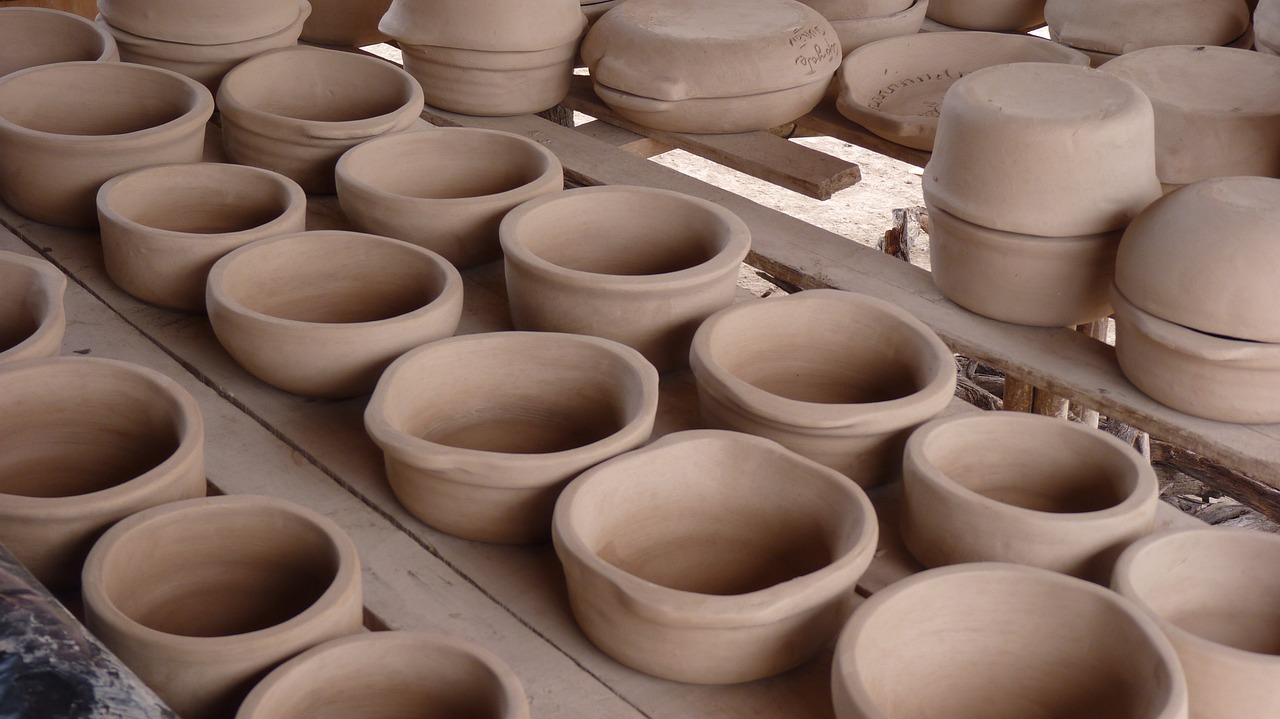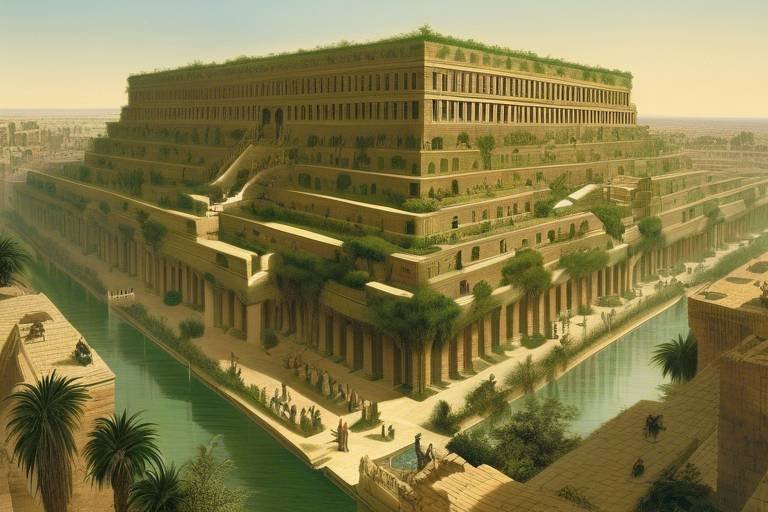The Mystery of the Ancient World’s First Libraries
Libraries, the repositories of human knowledge and wisdom, have a long and mysterious history that stretches back to the ancient world. These ancient libraries were not just collections of books; they were treasure troves of civilization's most valuable assets, safeguarding the cultural heritage of their societies. The origins of libraries can be traced to the dawn of civilization when written knowledge became a precious commodity, preserved in various forms to ensure its survival through the ages.
One of the most legendary ancient libraries was the Great Library of Alexandria, a beacon of intellectual enlightenment in the ancient world. Its vast collection of scrolls and manuscripts attracted scholars and thinkers from around the known world, making it a melting pot of knowledge and ideas. The enigma surrounding the fate of this iconic library only adds to its mystique, leaving historians and archeologists intrigued by its untimely demise.
Before the concept of libraries as we know them today emerged, ancient civilizations like the Sumerians relied on clay tablets to record and store information. These clay tablets, with their cuneiform inscriptions, laid the foundation for written communication and the preservation of historical records. The Sumerian clay tablets were not just mundane documents; they were windows into the past, offering insights into the daily lives and beliefs of ancient peoples.
In Nineveh, the Library of Ashurbanipal stood as a testament to the sophistication of Mesopotamian culture. Housing a vast collection of cuneiform tablets, this royal library provided a glimpse into the literary and scholarly achievements of the Assyrian Empire. The treasures unearthed from this ancient library shed light on the rich tapestry of Mesopotamian civilization, revealing a world of epic tales and profound knowledge.
Ancient Chinese libraries, on the other hand, relied on bamboo scrolls to preserve their literary heritage. These delicate scrolls, inscribed with classical texts and philosophical teachings, were revered as symbols of wisdom and enlightenment. The meticulous craftsmanship involved in creating and storing bamboo scrolls reflected the Chinese reverence for knowledge and the written word.
The Library of Pergamum, a renowned center of learning in the Hellenistic world, boasted a collection of papyrus scrolls that rivaled the Great Library of Alexandria. These papyrus scrolls, with their meticulously transcribed texts, played a crucial role in disseminating knowledge and fostering intellectual discourse. The rivalry between Pergamum and Alexandria underscored the competitive spirit of ancient scholarship and the quest for academic supremacy.
Among the ancient Mesoamerican civilizations, the Mayans stood out for their codices, intricate books that documented their history, astronomy, and religious practices. These codices served as invaluable repositories of Mayan knowledge, offering modern scholars a glimpse into the enigmatic world of this advanced civilization. The survival of these codices despite Spanish conquest and cultural upheaval is a testament to the resilience of Mayan culture.
The legacy of these ancient libraries continues to shape modern knowledge systems, influencing the way we access and disseminate information in the digital age. From the organization of archives to the design of digital repositories, the principles of library science established by our ancient predecessors remain relevant today. The mystery of the ancient world's first libraries lives on in the enduring quest for knowledge and understanding.

The Origins of Libraries in Ancient Civilizations
The origins of libraries in ancient civilizations can be traced back to the early stages of human history, where the need to preserve knowledge and culture led to the establishment of these unique repositories of wisdom. Ancient libraries served as the cornerstone of intellectual development, providing a sanctuary for written records, scrolls, and tablets that encapsulated the essence of ancient societies.
As civilizations flourished and expanded, the necessity to organize and store information became paramount. The emergence of libraries in ancient societies marked a pivotal shift in the preservation and dissemination of knowledge. These early libraries were not only repositories of written records but also served as centers of learning and cultural exchange.

The Great Library of Alexandria
The Great Library of Alexandria stands as one of the most iconic symbols of ancient knowledge and intellectual pursuit. Founded in the 3rd century BC, this legendary institution housed a vast collection of scrolls and manuscripts from across the known world. Imagine walking through its hallowed halls, surrounded by the collective wisdom of ancient civilizations, a true treasure trove of human thought and creativity.
Legend has it that the Great Library of Alexandria was home to hundreds of thousands of scrolls, covering a wide array of subjects ranging from philosophy and science to literature and history. Scholars and intellectuals from all corners of the ancient world flocked to this beacon of learning, eager to study, debate, and expand their understanding of the universe.
Despite its renowned status, the fate of the Great Library of Alexandria remains shrouded in mystery and controversy. The exact circumstances of its destruction are still debated among historians, with theories ranging from accidental fires to deliberate acts of sabotage. The loss of such a monumental repository of knowledge is often lamented as a tragic event in the annals of human history.
One of the enduring mysteries surrounding the Great Library is the question of what treasures and insights may have been lost to the sands of time. Could there have been undiscovered works of genius hidden within its shelves, waiting to be unearthed and shared with the world? The legacy of the Great Library of Alexandria continues to captivate the imagination of scholars and enthusiasts alike, serving as a reminder of the fragility and resilience of human knowledge.

The Role of Sumerian Clay Tablets
Libraries have always been more than just buildings with books. They are the keepers of knowledge, the guardians of history, and the gateways to enlightenment. In this article, we will embark on a fascinating journey through time to unravel the mysteries of the ancient world's first libraries.
From the dusty scrolls of Mesopotamia to the bamboo libraries of China, ancient civilizations laid the foundation for the libraries we know today. These repositories of wisdom were not just collections of texts but sacred spaces where scholars and scribes gathered to exchange ideas and preserve the collective knowledge of humanity.
The Great Library of Alexandria stands as a symbol of the intellectual prowess of the ancient world. Housing hundreds of thousands of scrolls from across the known world, it was a beacon of learning and a testament to the power of knowledge. Yet, its mysterious destruction has left historians and scholars puzzled for centuries.
Among the earliest forms of written knowledge storage, Sumerian clay tablets played a pivotal role in the development of libraries. These ancient artifacts, inscribed with cuneiform script, contained a wealth of information ranging from administrative records to epic tales. Imagine these tablets as time capsules, preserving the essence of an ancient civilization for future generations to decipher.
Furthermore, the organizational systems used to categorize and store these clay tablets laid the groundwork for the cataloging methods still used in modern libraries. The Sumerians were not just writing on clay; they were laying the bricks of the intellectual edifices that would stand the test of time.
Intriguingly, the discovery of the Library of Ashurbanipal in Nineveh, with its vast collection of cuneiform tablets, further solidified the importance of these ancient writing mediums in shaping the early libraries of the world. The intricate details etched into the clay reveal a civilization's beliefs, practices, and achievements, offering a glimpse into a bygone era.
The Library of Ashurbanipal in Nineveh, a treasure trove of cuneiform tablets, provides a window into the rich tapestry of Mesopotamian culture and literature. As one of the earliest known libraries in history, it stood as a testament to the intellectual curiosity and thirst for knowledge that transcended time and space.
Meanwhile, in ancient China, libraries housed bamboo scrolls containing classical texts and philosophical teachings. These delicate yet durable scrolls were meticulously crafted to withstand the test of time, ensuring that the wisdom of the sages would be passed down through generations.
In the Hellenistic world, the Library of Pergamum rivaled the Great Library of Alexandria in its collection of papyrus scrolls. These scrolls, with their versatile and portable nature, revolutionized the dissemination of knowledge and paved the way for the modern book format we know today.
Turning our gaze to Mesoamerica, the Mayan codices stand as unique examples of written records that preserved the history, astronomy, and rituals of the Mayan civilization. These intricate manuscripts were not just books but windows into a world where myth and reality intertwined in a tapestry of symbols and glyphs.
As we reflect on the legacy of these ancient libraries, we see their influence permeating modern knowledge systems. The principles of organization, preservation, and dissemination of knowledge established by our ancient predecessors continue to shape the way we access information in the digital age.
Stay tuned for answers to common queries about ancient libraries, their significance, and their enduring impact on modern society.

The Library of Ashurbanipal in Nineveh
The Library of Ashurbanipal, located in the ancient city of Nineveh, was a treasure trove of knowledge and culture during the reign of the Assyrian king Ashurbanipal (668–627 BC). This royal library housed a vast collection of cuneiform tablets, offering insights into various aspects of ancient Mesopotamian society, including literature, history, religion, and science.
One of the most remarkable features of the Library of Ashurbanipal was its collection of over 30,000 clay tablets, each inscribed with intricate cuneiform script. These tablets contained a wealth of information, from epic poems like the Epic of Gilgamesh to administrative records, legal codes, and scientific texts. The diversity of subjects covered in the library reflected the intellectual curiosity and scholarly pursuits of the Assyrians.
Moreover, the Library of Ashurbanipal played a crucial role in preserving ancient Mesopotamian culture and heritage. The cuneiform tablets housed in the library provided valuable insights into the daily life, beliefs, and achievements of the Assyrian civilization. Scholars and scribes would study and copy these texts, ensuring that knowledge was passed down through generations.
Furthermore, the Library of Ashurbanipal served as a center of learning and scholarship, attracting scholars from near and far to study its collection. The exchange of ideas and the dissemination of knowledge within the walls of the library contributed to the intellectual vibrancy of ancient Nineveh and solidified its reputation as a hub of culture and education.
In essence, the Library of Ashurbanipal in Nineveh stands as a testament to the enduring legacy of ancient libraries, showcasing the importance of preserving knowledge and fostering intellectual pursuits in civilizations of the past.

Ancient Chinese Libraries and Bamboo Scrolls
Ancient Chinese libraries hold a unique place in the history of knowledge preservation, with bamboo scrolls playing a pivotal role in storing and transmitting valuable information. During the ancient times, the Chinese developed sophisticated methods of organizing their collections, setting the foundation for modern library systems. Bamboo, a material known for its durability and flexibility, was widely used to create scrolls that contained a wealth of literary, historical, and philosophical texts.
Imagine walking into an ancient Chinese library, surrounded by shelves filled with meticulously crafted bamboo scrolls, each holding secrets of the past waiting to be unraveled. These scrolls were not just repositories of knowledge but also symbols of cultural richness and intellectual curiosity. Scholars and scribes meticulously inscribed characters on the bamboo, ensuring the preservation of important texts for future generations.
The use of bamboo scrolls in Chinese libraries revolutionized the way information was stored and accessed, paving the way for a more organized and systematic approach to knowledge management. The intricate craftsmanship involved in creating these scrolls reflected the Chinese reverence for learning and scholarship, emphasizing the importance of education in society.
Moreover, the portability of bamboo scrolls allowed for easy dissemination of information, enabling scholars and students to access a wide range of texts without constraints. The versatility of bamboo as a writing material made it ideal for creating scrolls of varying lengths, accommodating different types of content ranging from poetry and philosophy to historical records and scientific treatises.
As ancient Chinese libraries flourished, the bamboo scrolls became not just sources of information but artifacts of cultural heritage, embodying the wisdom and creativity of generations past. The meticulous preservation of these scrolls highlights the Chinese commitment to intellectual pursuits and the transmission of knowledge across centuries.
In conclusion, the use of bamboo scrolls in ancient Chinese libraries represents a significant chapter in the history of knowledge preservation, showcasing the ingenuity and dedication of ancient scholars in safeguarding valuable texts for posterity.

The Papyrus Scrolls of the Library of Pergamum
The Library of Pergamum, located in the ancient city of Pergamon in Asia Minor, held a remarkable collection of papyrus scrolls that rivaled the famed Library of Alexandria. These scrolls were crafted from the pith of the papyrus plant, providing a lightweight and durable medium for writing. The Library of Pergamum was renowned for its focus on parchment and papyrus scrolls, which were pivotal in the transmission of knowledge and culture during the Hellenistic period.
One of the most notable features of the papyrus scrolls in the Library of Pergamum was the development of parchment, a writing material made from animal skins. This innovation allowed for the creation of more compact and portable scrolls compared to traditional papyrus rolls. The use of parchment in combination with papyrus marked a significant advancement in the preservation and dissemination of texts, contributing to the library's reputation as a center of intellectual exchange and learning.
The diverse collection of papyrus scrolls in the Library of Pergamum encompassed a wide range of subjects, including literature, philosophy, science, and history. Scholars and scribes meticulously transcribed and preserved important works on these scrolls, ensuring that valuable knowledge from various disciplines was accessible to visitors and researchers. The scrolls served as a vital resource for scholars seeking to study and expand their understanding of the ancient world.
Furthermore, the Library of Pergamum played a crucial role in the development of writing and book production techniques. The meticulous cataloging and organization of the papyrus scrolls within the library set a standard for future libraries and archives, influencing the systematic arrangement of texts for centuries to come. The legacy of the Library of Pergamum's papyrus scrolls continues to resonate in modern libraries, where the classification and preservation of written materials remain fundamental practices.

The Mayan Codices and Knowledge Repositories
The Mayan civilization, known for its advanced knowledge in astronomy, mathematics, and hieroglyphic writing, left behind a remarkable legacy in the form of Mayan codices. These codices, made of bark paper and folded accordion-style, served as repositories of Mayan history, rituals, and astronomical observations. Each codex was meticulously crafted, containing intricate illustrations and hieroglyphic texts that provided insights into the beliefs and practices of the Mayan people.
Unlike the vast libraries of other ancient civilizations, the Mayan codices were relatively few in number, with only a handful known to have survived the ravages of time and conquest. These precious manuscripts offer a glimpse into the rich cultural heritage of the Mayan civilization, showcasing their sophisticated understanding of the cosmos and the natural world.
One of the most famous Mayan codices is the Dresden Codex, named after the city where it is housed. This codex, believed to have been created around the 11th century, contains detailed astronomical tables, ritual calendars, and predictions related to celestial events. It stands as a testament to the Mayan's expertise in astronomy and their complex calendar system.
Another significant Mayan codex is the Madrid Codex, which focuses on rituals, ceremonies, and divination practices. This codex provides valuable insights into the religious beliefs and practices of the Mayan people, shedding light on their spiritual worldview and the importance of rituals in their society.
Despite the limited number of surviving Mayan codices, their impact on our understanding of Mayan civilization is immense. These ancient manuscripts serve as invaluable sources of information for researchers, archaeologists, and historians seeking to unravel the mysteries of the Mayan culture and decode the intricate symbolism found within the codices.

The Impact of Ancient Libraries on Modern Knowledge Systems
Ancient libraries, with their rich collections of manuscripts and scrolls, have left an indelible mark on modern knowledge systems. The legacy of these repositories of wisdom continues to shape the way information is accessed, preserved, and disseminated in the digital age. By studying the organizational structures and cataloging methods of ancient libraries, modern institutions have been able to enhance their own systems for efficient information management.
One of the most significant impacts of ancient libraries on modern knowledge systems is the concept of centralized repositories. Just like the Great Library of Alexandria served as a hub for scholars and intellectuals in the ancient world, modern libraries aim to be central locations for accessing a wide range of information resources. The idea of a centralized collection that is open to the public has its roots in the ancient libraries that sought to gather and safeguard knowledge for future generations.
Ancient libraries also played a crucial role in the development of classification systems. The categorization and organization of texts in libraries such as the Library of Ashurbanipal in Nineveh set a precedent for modern library cataloging systems. By adopting and adapting these early classification methods, modern libraries are able to provide users with efficient ways to locate and retrieve information from vast collections.
The digitization of ancient texts and manuscripts has been another significant impact of ancient libraries on modern knowledge systems. Through initiatives to preserve and digitize ancient writings, modern scholars and researchers have gained unprecedented access to historical texts that were once confined to the shelves of specialized libraries. This digital preservation effort ensures that valuable knowledge from the past is not lost to time but is instead made available to a global audience.
Ancient libraries also inspire modern institutions to prioritize the preservation of cultural heritage. The meticulous efforts to safeguard and protect ancient manuscripts and artifacts from libraries like the Library of Pergamum serve as a reminder of the importance of preserving cultural heritage for future generations. By learning from the practices of ancient librarians, modern institutions can better protect and promote cultural treasures in the digital age.
In conclusion, the impact of ancient libraries on modern knowledge systems is profound and far-reaching. From organizational structures to preservation efforts, the influence of ancient libraries can be seen in every aspect of how information is managed and shared today. By studying the history and practices of ancient libraries, modern institutions can continue to evolve and adapt to meet the changing needs of information seekers in the 21st century.
Frequently Asked Questions
- What were the primary functions of ancient libraries?
Ancient libraries served as repositories of knowledge, preserving historical records, literature, scientific advancements, and cultural heritage. They were centers of learning, where scholars and scribes gathered to study, copy manuscripts, and engage in intellectual discourse.
- How were ancient libraries organized?
Ancient libraries were typically organized by subject matter or material type. Scrolls, tablets, or codices were cataloged and stored in designated areas within the library. Librarians, often scholars themselves, maintained the collection and assisted visitors in accessing the desired texts.
- What was the significance of the Great Library of Alexandria?
The Great Library of Alexandria was renowned for its vast collection of scrolls from various cultures and disciplines. It was a symbol of intellectual prowess and a hub for scholars from around the ancient world. The library's destruction remains a subject of historical debate and mystery.
- How did ancient libraries influence modern knowledge systems?
Ancient libraries laid the foundation for modern libraries, archives, and educational institutions. They established the importance of preserving and disseminating knowledge, a principle that continues to shape contemporary information management practices and scholarly pursuits.



















